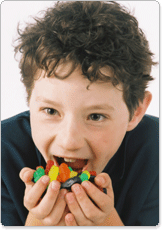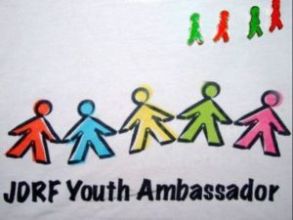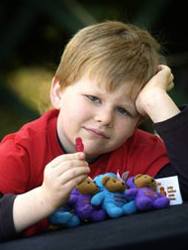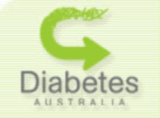Lately, I have had a glut of phone calls from people who know a family that are dealing with Type 1 Diabetes diagnosis, and for some reason, they end up with my details.
JDRF Australia estimate that there are 5 new cases of Type 1 Diabetes diagnosed everyday.
In the past weeks, I have spoken to mothers who have not slept more than an hour for two weeks straight, fathers’ who have had to pick up the pieces and continue running the household, and big sisters who are suffering in school because they are falling asleep in class from lack of sleep.
When Diabetes invades, it gives no warning, and it’s just like everything you have been doing for the past years with your family has to stop, and a new plan and system has to be installed to accommodate everybody.
I wanted to make a list for people who have just had a young child diagnosed, and who have been too overwhelmed with hospitals, doctors, drips and diets to fully grasp what they are going to come home to. I have tried to include some of the more challenging situations as well, as it’s always reassuring to learn that someone else has been through it before you!
Here it is..my very extended version of how to deal with some feelings and situations that often go unspoken.
*Obviously, your child will have been very ill before you were told to rush to the hospital. You may have washing to catch up on, general cleaning.. It is a fantastic idea (rather than flowers or gifts) if your family can join together to hire a cleaner, so that you at least can exist in a clean environment, without the everyday burden of housework.
*When your child is finally discharged from the hospital, it is a very overwhelming experience to walk into your home-pre diabetes. Diabetes Educators and nurses are encouraged to have the family involved as much and as soon as possible with finger pricking, giving injections, and taking care of your child, just as you would as if you were at home. The constant visits from your Diabetes Care Team and family often distract you enough that you haven’t even come to terms with the fact that your child has been diagnosed with a chronic illness. As soon as you can, make an appointment with your GP, as you will no doubt be in severe shock, and only just beginning the grieving process. Your GP can offer you lists of Support Groups in your area, Diabetes Educators, Counsellors. If you have more than one child, it really is imperative that the main care giver (at least) is able to vent and learn some coping mechanisms with this new full time responsibility.
*All hospitals in Australia ensure that a newly diagnosed patient visits or contacts Diabetes Australia in their state, and becomes a member of the National Diabetes Services Scheme. The NDSS will provide huge discounts of your everyday requirements, such as test strips, ketone strips, and syringes or needle ends for insulin pens. Often, major diabetes drug companies will give families a glucometer at no charge-obviously, you weren’t budgeting for all of this new equipment. (We are so lucky living in Australia, test strips are often no more that $1 for a pack of 100, and syringes and needle ends are free to those with a NDSS card. You will receive a card whilst at Diabetes Australia, or with your order.) When you arrive back at the hospital with bags full of new and foreign items, a diabetes educator will sit down with you and run through how to load an lancet device, or how to get a glucometer ready and waiting whilst you get a sample of blood to test. Ask as many questions as you need to- that’s what they are there for.
*Most endocrinologists who are looking after your child’s insulin requirements will offer their mobile number or a private number, so that you can administer insulin doses yourself, whilst still knowing that your child will most likely be safe under the endocrinologist’s orders. NEVER FEEL AFRAID OR LIKE YOU ARE GOING TO WAKE UP THE DOCTOR: the endos often take it in turns week by week to answer the phone-they are well versed and non plussed regarding a panicked query at 2am with a 2.3mmol/L reading. It is much better to call the doctor, than to rush back to the to the hospital and put your child (and you) through more trauma.
* Your endocrinologist will be able to fill out a form for you called a Treating Doctor’s Report. You will have to fill in one too, and upon returning them to Centrelink, you are entitled to the Carer’s Allowance, which assists people with high maintenance Chronic illnesses-like Type 1 Diabetes- with medications, healthier choices at the supermarket, and emergency after-hour doctor fees.
*Were you not told about about a product called GLUCAGON whilst in hospital? If the answer is no, make an appointment the very next day so that you can get a script from your doctor. Most children are in the Honeymoon Period when they are diagnosed, so the risk of a severe hypoglycaemic attack is quite rare. However, they do happen, and the Honeymoon Period will eventually pass-whether it be days or months after commencing Insulin Therapy. You need to ensure that you have the “orange plastic box” with a prefilled syringe of sterile water and a vial of powder inside. There are clear and concise instructions inside the lid of the box, and also paperwork with detailed information included in the box. You will need to have this product with you, wherever you go, or somewhere safe and accessible in the house. IT HAS SAVED MY SON’S LIFE ON MORE THAN ONE OCCASION.
*Store all of your insulin away in the fridge as soon as possible. The vials or pens that you will be using on a daily basis should live in a cool area, preferably inside a dark coloured, plastic snaplock box. Find a good place where every member of the family can reach the insulin,glucometer, test strips and lancets, and it’s really helpful to keep it all together in one larger clear box with a lid. Insulin not being stored in the fridge has an effective life of 30 days. Any longer, and it is very obvious that the insulin has lost its strength, as you will have high numbers bouncing all over the place.
*You will need to learn to travel everywhere with a hypokit, either in a backpack, or in the case of a Mum with a young baby, you will need a huge nappybag with lots of zips and pockets. A hypokit should contain: A Glucagon Kit, ample jellybabies or jellybeans, fruit juice in a box with a bendy straw, some plain biscuits and muesli bars to give your child after you have treated their hypo, a sachet of sugar, honey and jam, (in case you have to rub into the cheeks of a baby who is hypo and screaming,) an identification card with your child’s photo and name and your contact details, clearly stating that the child has TYPE 1 DIABETES. Your endo, GP, educator and spouses details are handy to have speed-dialled into your mobile phone in emergencies.
* You will have to have hypokits around the home, too. Even if it’s a jar of jellybabies on top of the pantry, or a shelf in the pantry devoted to treating low blood sugar, that everybody in the household knows is exclusively for hypoglycaemic emergencies.
* You will need to find a suitable bracelet or necklace and get your child’s name, contacts and condition engraved into it. There is a fantastic Australian organisation called diabetes-ezy who have really modern, funky designs,(especially for young boys!!) rather than the clunky, unflattering Medic Alert handcuffs of ten years ago.
* When your child is first diagnosed, and commences insulin therapy, it is a really, horrible and stressful time, as blood sugar levels can fluctuate from 2mmol/L to 30mmol/L within an hour-even when little food is consumed. It’s a lifesaver to buy a cheap exercise book, and make notes about what was happening when a hypo/hyper occurred, if there was any outside stress, illness, excess energy expenditure, too many carbohydrates or too much/not enough insulin given. Eventually, you can start to piece together the puzzle and work out the warning signs of a potential emergency, and learn about your child and their Diabetes. (It does seem impossible at first, but speaking from the hugest Doubting Thomas there is, eventually,a bright, shiny lightbulb will appear above your head.)
* It is particularly annoying having to write down every finger prick result. A lot of logbooks designed for recording blood sugar readings never have enough room, and end up in a huge, confusing mess. Again, an exercise book with a pen attached is initially handy to record the number on, then, at the end of the day, you can record ALL of your child’s results into a program such as www.sugarstats.com . You can then print out the results every 3 months to give to your endo.
* There is no denying it..Diabetes causes strain or stress even in the strongest of relationships/marriages. Don’t let Diabetes take over the family..it is so easy to say this now of course, but back when Lance was diagnosed, all I did was watch him breathe, read every book from the library about Diabetes, collate numbers and averages for the week, sit in bewilderment asking myself over and over again why this could have happened….I can see myself cramming as much information as I could into my head, and my marriage slipping away everyday without me even noticing. Find time to talk to one another, even if you are so exhausted that you can barely think, even 15 minutes of strictly non-diabetes talk can do wonders. It’s still important for your partner to feel as though he/she means exactly the same to you before the diagnosis. If anything, they are more important now than ever before! It’s just so incredibly important to TALK.( And drop the D word for a few minutes each day.)
* It’s vital that if your child needs to see an emergency doctor/pharmacy/dentist that they are informed promptly about your child’s condition. It basically has to sound like this. “Hi, this is my son, he is 7 and he has had Type 1 Diabetes for 5-and-a-half-years. He has regular insulin injections.”
* I have always made people very aware of Lance’s condition. I feel that no matter what age of the child, that it is really important that people know that your child has diabetes. Your child will feed off your confidence, too. (It’s almost at the point where I think Lance is proud of his Diabetes, as he will often engage in conversation with complete strangers and tell them about his adventures living with the Beast.) In older children, who remember a world without Diabetes, it can be more difficult, but in all seriousness, you are protecting your child by educating them to be proud and say “I have Type 1 Diabetes.” It could even one day save their life.
* Many parents ask me, ” I am never going to have my life back again, am I? or “When will I start to accept that this isn’t going to go away?” The good news is that you will most certainly have your life back again. It is often helpful to look at Type 1 Diabetes as a new lifestyle, more than a potentially life-threatening chronic condition. You do what you always did before the diagnosis, and ensure that your child receives their snacks, meals, insulin, exercise-along with lots of love, hugs and Mum/Dad-time. Naturally, your garden may have a few more weeds, or you mightn’t have your floor mopped until it sparkles everyday, but you do what is important first, and ensure that your family realises that they have extra responsibilities now. The other question is a tricky one. Recently, after almost 6 years of living this regimented life, I got really angry, and I was furious that I wasn’t “allowed” to have a minute away from Diabetes. There is no holiday. There is no weekend off. Diabetes Burnout is totally normal and very common, and can re-occur at any stage of being a carer. You aren’t a bad parent for wanting you old life back. You aren’t a weak person for feeling guilty that your child has your genes. You aren’t a terrible person for wanting to scream everytime you get a horrorshow reading on the glucometer. However, after a while, when levels start to become more regular, and life begins to develop a familiar pattern again, the hypos will settle down, and the nasty surprises become a rarity, you can suddenly recognise that “WOW! I have some control back!” Unfortunately, it does take time, and it takes a lot of work. With support, and there is SO much available, you can get through the sticky patches and get back on track again.
* Your child may be very anxious about resuming school, after being diagnosed with Type 1 Diabetes. Ask your paediatrician if he/she will come along to your child’s class,(most are very obliging,) and explain how sick your child was, and give an age-appropriate explanation of what Diabetes is. They will make sure that the teacher is thoroughly aware of looking out for symptoms of hyperglycaemia or hypoglycaemia-as will you! Parents often fret more than than the child about returning to school with Diabetes! In fact, many children are very interested to learn about Diabetes or witness a hypo or a fingerprick! A child with Diabetes almost receives hero status for being so brave to have to stick needles into themselves all day long. It is a responsible thing to do to write a letter to the parents of your child’s classmates, and really drive home the point that “Lance had no control over developing diabetes, in fact there was nothing anybody could do to stop it from occurring.” At 5 years of age, Lance was the unfortunate victim of being the only child in his preschool class to be un-invited to his best friends birthday party. When confronted, the parents admitted that they were too wary to ask me about what to do about cake, soft drinks etc, or if the party was ruined should an ambulance be called. Inform parents that you are going to be with your child at events such as birthdays,sports days, get-togethers, and that you will be constantly monitoring their levels-insulin-activity ratio. A birthday is a reason to get down and funky with some serious birthday cake; there is NO reason for your child to miss out. Chances are that they have been so busy enjoying themselves that they actually needed some carbohydrates anyway, and even if they are at the higher end of “normal,” I can assure you they will not mind in the least at receiving a unit or two extra of insulin!
* It’s a positive move to use words and phrases like..”Lance had a hypo today, didn’t you sweetheart? We worked as a team to get you feeling well quickly though, and we had you safe again very quickly.” rather than “Oh God..Lance had a serious hypoglycaemic attack-it was a really bad episode.” Same deal applies for “Lance is a little high today, we’ll just have to keep a very close eye on him today, lots of water and maybe some jumps on the trampoline, buddy?” rather than “Get the ketone sticks, get him to pee on a stick everytime he goes to the toilet, his blood sugar is through the roof! This has been a really bad hyper-I wonder what he/we did wrong?” Kids actually do panic when they hear their parents speak even in hushed tones about serious issues. Stress is only going to accentuate the situation. Try to remain as calm as you can and re-inforce that your child is going to be fine. Let them know that you have everything needed to get their blood sugar level back to a safe range again, and that they just have to take it easy and relax. “Your level is bad/good” should be replaced with “Your level is high/normal/low.”
* The best thing that ever happened out of Lance’s diagnosis was discovering the amazing, inspirational team of people who devote their lives to working for the Juvenile Diabetes Research Foundation. (JDRF Australia.) Lance has had so many incredible experiences as a result of being a Youth Ambassador. He has met with politicians, and even travelled to Parliament House in Canberra. In fact, after this Jelly Baby Month, Lance and I have raised $6000-funds that go directly towards finding a cure. JDRF have a fantastic website, and bi monthly magazines that come out with the latest news regarding the hunt for a cure. Lance has featured in national and international publications, and he has become a well known face in our city. JDRF provide kids with Type 1 Diabetes with the tools to become powerful public speakers, they have enhanced confidence and strive for the best life they can live. Contacting this organisation is possibly the very best thing you can do for your child. It costs very little to become a member, and the benefits received are priceless.
* This is still an issue that I have great problems dealing with. For the first 5 years after diagnosis, I had huge anxiety attacks about leaving Lance with someone who doesn’t have “the trained eye.” By joining a local support group, you are going to meet other parents who know your situation only too well. Often, if it is a couple’s wedding anniversary or there is another important event that is not child friendly on the calendar, other parents will be only too happy to watch your child for a few hours. Of course you are going to be a nervous wreck, and be sneaking off to make check-up calls, but at least you made it out the door without a glucometer in your handbag! Often a family member who has gathered the major concepts of the too low-give sugar, too high-give water and “call me ASAP!” are great standbys also. The first time I left Lance with others, I had to end up coming home, because I was so distressed and distracted, but I have since learnt that he would be horrified to see me bursting through the door if he knew I was supposed to be out enjoying myself with friends!
Also, words like “amputation, kidney failure, heart disease, blindness or coma” should definitely not be used in front of your young child as examples to explain the serious nature Type 1 Diabetes can be to those who aren’t “in the know.” Kids with Type 1 Diabetes often lose a big part of their childhood from going to appointments, having blood taken from them regularly, dealing with sick days, missing out on camps, not having a sleepover without you on the sofa bed in another bedroom, sitting out a soccer game because they are low… They really don’t need to know about any of these terms until they stumble across it themselves. They have quite enough to deal with as it is.
* There are times when your child is sick, or very vulnerable, and you mind trails off, wondering if or when complications are going to set in. A nurse told me only 24 hours after knowing that my son had Type 1 Diabetes, that at least I could be assured that I would have a “good 15 years left with him.” I returned to his cot and cried and sobbed, envisioning losing my son at 15 years of age. When the head nurse hurriedly appeared after learning that there was a mother in great distress, I was so paranoid and confused that I actually made her show me written evidence to prove that a child with Type 1 Diabetes can have a long, happy and adventurous life. I can understand now, that even in the six years since Lance was diagnosed, that there has been SO much progress made- there was a time where maybe that nurse was told to give parents of newly diagnosed babies such a ghastly “timeframe”. Nevertheless, I was informed the next day by the Head Nurse that she had been given a crash course of Type 1 Diabetes for the 21st Century!!!
*Whilst in hospital, most Diabetes Educators or nurses will ensure that you speak with a Dietician. Sometime before you arrive home, you are going to have to get someone to go to the supermarket and buy essentials. You will learn why carbohydrates will become your child’s new best friend, and all about the Glycemic Index. It won’t take long before you know what works well for your child and what to avoid. Some kids have huge fluctuations if they drink cow’s milk. Lance can eat 5 mandarins and his blood sugar will not budge. A perfect example of how each child and each case of Diabetes is different.
*I am often asked what changes I have had to make to Lance’s diet since he was diagnosed. As an example, (and as as he has become a robust, ravenous 7-and-a-half year old, who is going through a MAJOR growth spurt,) I have listed what he has eaten today.
A nutritious example of a diet complete with calcium, 2 pieces of fruit, 5 servings of vegetables, and plenty of wholegrains for Lance would be:
Breakfast (after finger prick and insulin dose)
A serve of rolled oats (oatmeal for our American friends), a watered down glass of Apple Juice, and an apple cut into segments.(skin on.)
Morning Tea: 10 grapes, 2 plain biscuits and a tumbler of water
Lunch: 2 slices of grainy thick bread, with pizza vegetables and grated cheese and grilled with fresh herbs, a glass of milk.
Afternoon Tea: Slice of Gluten Free Apple and Walnut Tea Cake, glass of apple and pear juice.
Dinner: A serve of protein as big as the palm of my hand..(chicken breast, white fish, lean steak) accompanied by roasted starchy herbed vegetables eg potatoes, pumpkin, sweet potato, carrots, corn…and/or steamed green beans, broccoli. A Tub of yoghurt for dessert or home made Apple Crumble.
Supper: Water Crackers, cheese cubes, sultanas and 1 square of chocolate.
As you can see, there is a LOT of food consumed throughout the day! You will quickly learn that apple juice instead of orange juice will keep your child’s blood sugar from soaring to 12mmol/L and more likely keep it at 7/8 mmol/L and for a longer period of time. It’s really important for your child to go to bed with a blood sugar level of no lower than 7mmol/L. I am happy if Lance is 7.5mmol/L just before he closes his eyes. Night hypos or “Nypos” are frightening and horrible, not to mention dangerous and even life threatening. I have had people question giving Lance a square of chocolate before bed… Chocolate actually has a low to moderate count on the Glycemic Index, and it is great to be able to reward him for taking such good care of his body all day long! I can’t emphasise how important it is to give your child supper before bed, even if they did a great job with their evening meal.
* At my first formal Diabetes “class”, we were all told about how people with Diabetes will take longer to heal regarding skin abrasions/illnesses. Lance actually sneezed during that session. Everybody looked at me like I was supposed to instantly whip out disposable paper face masks… Sure enough, later that evening, Lance’s BSL was HI and his temperature was through the roof. He was coughing and crying and I sat down beside his cot and imagined that it was going to take 6 months for him to heal from a cold. He had fully recovered in 4 days. If he falls and grazes his hand, some extra care with some antiseptic lotion and he has gorgeous new pink skin a few days later. Diabetes is often about making smart(er) choices, and taking extra care. Most issues can be dealt with just like a person without Type 1 Diabetes if you use common sense and stay aware and alert.
*My hugest fear as a parent and carer of a child who has Type 1 Diabetes….Gastro Viruses. Ohhhh… I am already out in a cold sweat just thinking about it. Here’s the deal. If you child is a toddler or very young, and suddenly sends a huge cylinder of vomit flying through the air, everything is going to change from that moment on. You are going to have to have your glucometer strapped to you, and wait for whatever the last insulin dose you gave to wear off. Expect a hypo-strong words, I know, but it’s reality. After being sick, little kids, and sometimes even older children are not going to want anything going near their mouthes. Panadol, ice, glucose tablets will all get thrown back at you. They are naturally afraid of such a repugnant reaction to happen again-so they will not eat, even if you cry, beg, plead. If you are on an insulin pump, the Gastro Bug isn’t as scary. However, if you are doing it old school via insulin pens or syringes, you are going to have to contact a member of your Diabetes support network to help you work out how much insulin to give. Even though your child is sick and not eating, INSULIN MUST STILL BE GIVEN. You just have to give less of it, more frequently. If you start getting high readings, and your child is hot and crying, press a ketone strip into their nappy, or if they are old enough, explain how to use them. If you see colour changes in the ketone line, you need to go to hospital immediately. Diabetic Ketone Acidosis (DKA) is a life threatening illness that occurs when the body starts to self-cannibalize itself, as a result of not enough insulin. Your baby will have to go on a drip, to ensure that they do not dehydrate, and most kids recover pretty quickly when a vomiting retardant such as Maxolon is given through the drip. However, be prepared for psychological issues for a few days. Some kids are scared to eat again in fear of repeated episodes of vomiting. Start with baby steps-ice chips are great. If they are happy with those, you can move up to Lucozade ice chips. Then sips of lemonade, or a piece of toast…eventually they will gain their confidence back. My family are all nurses, and love to tell me about how their is wards full of people in hospital with stomach viruses that are unshakable for 2 weeks….I tried to be a superhero once, and sit through a week of crying, fingerpricking, irrational behaviour, triple the amount of washing to do, checking temperatures, giving hourly insulin…it’s just a nightmare. I know now, that if it’s going to happen, and there isn’t any signs of recovery within 24 hours..off to hospital we go.
*On that note, it is really great to teach your child to learn to become a vigilant hand-washer. Without encouraging obsessive compulsive behaviour, it’s good to get your child to wash their hands before they eat, have their own individual portions of food, wash their hands if they have patted the cat or the dog, and an antibacterial wipe over your child’s hands after being at the supermarket/doctor’s surgery/pharmacy can never hurt, either.
*Almost six years on, I have learnt so much..and I’m actually proud to say that I worked most of it out by myself. There is nothing more heartbreaking than jabbing a baby with needles, and sending yourself around the twist as you watch them breathe as they sleep. I got there. I have a child who stands almost up to my shoulders to prove it. He’s as strong as an ox and as healthy as a horse. Don’t forget to enjoy your baby, even if you have to deal with Type 1 Diabetes. They are only so little for such a short time..they are still perfect little blessings that need to be saturated with love and care. You will get there too! I already have a little man who smothers me with love and hugs. I guess, even throughout the thousands of needles and fingerpricks, he figured out that I love him unconditionally.




















